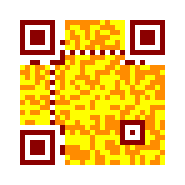QR Code and Micro QR Code serialization¶
A QR Code or Micro QR Code is independent of its output, it’s just a matrix. To save a QR Code or Micro QR Code, Segno provides several output formats.
Segno provides a segno.QRCode.save() method to serialize the (Micro)
QR Code in different formats:
>>> import segno
>>> qr = segno.make('Polly')
>>> qr.save('polly.svg')
>>> qr.save('polly.png')
>>> qr.save('polly.eps')
All serializers accept a border parameter which indicates the “quiet zone”
of a (Micro) QR Code. If border is None, the default border (quiet zone)
size will be used. If the resulting (Micro) QR Code should have no border or
a custom border, the user may specify the border explicitly.
>>> import segno
>>> qr = segno.make('Vampire Blues')
>>> qr.save('vampire-blues.svg', border=0) # No border
>>> qr.save('vampire-blues.png', border=10) # Larger border
Most serializers accept a scale parameter which indicates the scaling
factor of the serialization. By default, the scaling factor is 1 which means
that size of a dark / light module is interpreted as one unit in the specific
user space (i.e. 1 pixel for the PNG serializer or
1 point (1/72 of an inch) in EPS). Some serializers
(like PNG) accept only an integer value or convert the provided
scaling factor to an integer. Other, like SVG and EPS,
accept float values and do not “downgrade” it to an integer.
>>> import segno
>>> qr = segno.make_qr('The Beatles')
>>> qr.save('the-beatles.png', scale=1.2) # No scaling at all since int(1.2) is 1
>>> qr.save('the-beatles-2.png', scale=10) # 1 module == 10 pixels
>>> qr.save('the-beatles.svg', scale=1.2) # SVG accepts float values
>>> # The SVG serializer provides the "unit" parameter to specify
>>> # how to interpret the values
>>> qr.save('the-beatles-2.svg', scale=10, unit='mm') # 1 unit = 1 mm
>>> qr.save('the-beatles-2.svg', unit='cm') # 1 unit = 1 cm, result as above
Many serializers accept the parameters color and background to specify
the color of the dark modules and light modules (background). See Colors
for details.
>>> import segno
>>> qr = segno.make('Neil Young')
>>> qr.save('neil-young.svg', color='darkblue', background='yellow')
>>> qr.save('neil-young.png', color='#ccc')
>>> qr.save('neil-young-2.png', background=None) # Transparent background
>>> # Dark modules = transparent, light modules = black
>>> qr.save('neil-young-3.png', color=None, background='black')
>>> # Dark modules with alpha transparency
>>> qr.save('neil-young-4.png', color='#0000ffcc')
>>> qr.save('neil-young-4.svg', color='#00fc') # Same as above but SVG
>>> # Anonther color, save as compressed SVG
>>> qr.save('neil-young-5.svgz', color=(8, 90, 117))
If the QR Code should be serialized to a buffer, use the
kind parameter to specify the output format.
Please note that some serializers write bytes while others write strings, see
segno.QRCode.save() for details.
>>> import segno
>>> import io
>>> qr = segno.make('Neil Young')
>>> buff = io.BytesIO()
>>> qr.save(buff, kind='svg')
>>> # All other serializer parameters are supported as well
>>> buff = io.BytesIO()
>>> qr.save(buff, kind='svg', color='#ccc', background='green')
See segno.QRCode.save() for a complete reference which parameters are
accepted by the specific serializer.
More colorful QR Codes¶
The PNG serializer supports an optional color mapping which can define a specific color for each module type.
>>> import segno
>>> from segno import moduletypes as mt
>>> qr = segno.make('Yellow Submarine', error='h')
>>> colormap = {mt.TYPE_FINDER_PATTERN_DARK:'darkred', mt.TYPE_ALIGNMENT_PATTERN_DARK:'darkred', mt.TYPE_TIMING_DARK: 'darkred', mt.TYPE_DARKMODULE: 'darkred', mt.TYPE_DATA_DARK: 'darkorange', mt.TYPE_DATA_LIGHT: 'yellow', mt.TYPE_FORMAT_DARK: 'darkred'}
>>> qr.save('yellow-submarine.png', scale=5, colormap=colormap)

Available serializers¶
- ANSI
- ANSI escape code. The serializer supports the border keyword, only. See ANSI for details.
- EPS
- Encapsulated PostScript (EPS). The serializer provides all default features (scale, border, color and background color), see EPS for details.
- LaTeX
- LaTeX / PGF/TikZ. The serializer provides no background color, but all other default features (scale, border, color) are supported, see LaTeX for details.
- PAM
- Portable Arbitrary Map (PAM). The serializer provides all default features (scale, border, color and background color), see PAM for details.
- PBM
- Portable Bitmap (PBM). The serializer does not support any coloring, but the common featurs like scale and border are supported, see PBM for details.
- Portable Document Format (PDF). The serializer provides all default features (scale, border, color and background color), see PDF for details.
- PNG
- Portable Network Graphics (PNG). The serializer provides all default features (scale, border, color and background color) and a few more to customize the output, see PNG for details.
- SVG
- Scalable Vector Graphics (SVG). The serializer provides all default features (scale, border, color and background color) and many more to customize the output, see SVG for details. SVGZ (compressed SVG) is supported as well.
- TXT
- Text output. The serializer does not support any scale or color, but the character for the dark and white modules may be specified via color and background, see TXT for details.
- XBM
- X BitMap (XBM). The serializer does not support any coloring, but scale and border are supported, see XBM for details.
- XPM
- X PixMap (XPM). The serializer provides all default features (scale, border, color and background color) and a few more, see XPM for details.